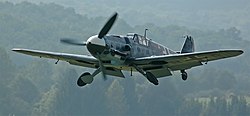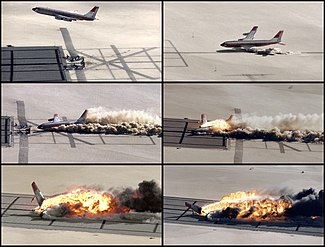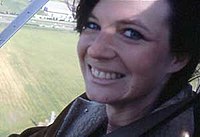Portal:Aviation
| Main page | Categories & Main topics |
|
Tasks and Projects |
The Aviation Portal

Aviation includes the activities surrounding mechanical flight and the aircraft industry. Aircraft includes fixed-wing and rotary-wing types, morphable wings, wing-less lifting bodies, as well as lighter-than-air craft such as hot air balloons and airships.
Aviation began in the 18th century with the development of the hot air balloon, an apparatus capable of atmospheric displacement through buoyancy. Some of the most significant advancements in aviation technology came with the controlled gliding flying of Otto Lilienthal in 1896; then a large step in significance came with the construction of the first powered airplane by the Wright brothers in the early 1900s. Since that time, aviation has been technologically revolutionized by the introduction of the jet which permitted a major form of transport throughout the world. (Full article...)
Selected article
Arkia was founded in 1949 as Israel Inland Airlines when it became clear that there was demand for a local airline to connect the north of Israel (especially Tel Aviv) with the southern region of the Negev, as a subsidiary of El Al, Israel's national airline. Flights starting the following year with the airline unsing De Havilland DH.89 aircraft, followed by Douglas DC-3s, to connect Rosh Pina in the north to the port of Eilat in the south. El Al held a 50% stake in the airline at this time with Histadrut, Israel's labour federation, being the other shareholder. The airline later evolved to become Eilata Airlines, Aviron, and then to Arkia Israel Airlines. In its first year of service, Israel Inland carried 13,485 passengers on their twice weekly flight, operated by a Curtis Commando. (Full article...)
Selected image
Did you know
...that Guy Menzies flew the first solo trans-Tasman flight (from Sydney to New Zealand) in 1931, but landed upside-down in a swamp?

...that the Battle of Britain Memorial Flight contains the world's oldest airworthy survivor of the Battle of Britain, alongside ten other historic aircraft - two of which fought over Normandy on D-Day? ...that the asymmetrical monoplane BV 141 is one of many military aircraft designed by Richard Vogt?
General images -
In the news
- May 29: Austrian Airlines cancels Moscow-bound flight after Russia refuses a reroute outside Belarusian airspace
- August 8: Passenger flight crashes upon landing at Calicut airport in India
- June 4: Power firm helicopter strikes cables, crashes near Fairfield, California
- January 29: Former basketball player Kobe Bryant dies in helicopter crash, aged 41
- January 13: Iran admits downing Ukrainian jet, cites 'human error'
- January 10: Fire erupts in parking structure at Sola Airport, Norway
- October 27: US announces restrictions on flying to Cuba
- October 3: World War II era plane crashes in Connecticut, US, killing at least seven
- September 10: Nevada prop plane crash near Las Vegas leaves two dead, three injured
- August 6: French inventor Franky Zapata successfully crosses English Channel on jet-powered hoverboard
Related portals
Associated Wikimedia
The following Wikimedia Foundation sister projects provide more on this subject:
-
Commons
Free media repository -
Wikibooks
Free textbooks and manuals -
Wikidata
Free knowledge base -
Wikinews
Free-content news -
Wikiquote
Collection of quotations -
Wikisource
Free-content library -
Wikiversity
Free learning tools -
Wikivoyage
Free travel guide -
Wiktionary
Dictionary and thesaurus
Selected biography
Despite her surname, Jeana Yeager is not related to Chuck Yeager, the first man to break the sound barrier in level flight.
Selected Aircraft

The Messerschmitt Bf 109 was a German World War II fighter aircraft designed by Willy Messerschmitt in the early 1930s. It was one of the first true modern fighters of the era, including such features as an all-metal monocoque construction, a closed canopy, and retractable landing gear. The Bf 109 was produced in greater quantities than any other fighter aircraft in history, with a total of 33,984 units produced up to April 1945. Fighter production totalled 47% of all German aircraft production, and the Bf 109 accounted for 57% of all German fighter types produced.
The Bf 109 was the backbone of the Luftwaffe fighter force in World War II, although it began to be partially replaced by the Focke-Wulf Fw 190 from 1941. The Bf 109 was the most successful fighter of World War II, shooting down more aircraft than any of its contemporaries. Originally conceived as an interceptor, it was later developed to fulfill multiple tasks, serving as bomber escort, fighter bomber, day-, night- all-weather fighter, bomber destroyer, ground-attack aircraft, and as reconnaissance aircraft.
The Bf 109 was flown by the three top-scoring fighter aces of World War II: Erich Hartmann, the top scoring fighter pilot of all time with 352 victories, Gerhard Barkhorn with 301 victories, and Günther Rall with 275 victories. All of them flew with Jagdgeschwader 52, a unit which exclusively flew the Bf 109 and was credited with over 10,000 victories, chiefly on the Eastern Front. Hartmann chose to fly the Bf 109 in combat throughout the war, despite being offered the use of the Me 262. Hans-Joachim Marseille, the highest scoring German ace in the North African Campaign, also scored all of his 158 victories flying the Bf 109, against Western Allied pilots.
- Span: 9.925 m (32 ft 6 in)
- Length: 8.95 m (29 ft 7 in)
- Height: 2.60 m (8 ft 2 in)
- Engine: 1× Daimler-Benz DB 605A-1 liquid-cooled inverted V12, 1,475 PS (1,455 hp, 1,085 kW)
- Cruising Speed: 590 km/h (365 mph) at 6,000 m (19,680 ft)
- First Flight: 28 May 1935
Today in Aviation
- 2012 – The airline Wind Jet ceases operations after Alitalia's attempt to purchase it fails, leaving hundred of passengers stranded in Italy.[1]
- 2011 – A NATO airstrike against Libyan government positions in Brega destroys two armored vehicles and kills six Libyan Army soldiers.[2]
- 2011 – The French Navy aircraft carrier Charles de Gaulle returns to Toulon, France, after more than four months of continuous operations off the coast of Libya.[3]
- 2005 – An AH-64A Apache 90-0442 from C Company, 8–229th Aviation Regiment crashes near Kirkuk, injuring both crewmembers. Helicopter is written off.[4]
- 1985 – Japan Airlines Flight 123, a Boeing 747, crashes into Mount Osutaka after catastrophic failure of the tailplane severs all hydraulic lines and renders the aircraft uncontrollable. 520 of 524 people on board are killed. To date, it is the worst single-aircraft disaster in history.
- 1979 12-17 – Ben Abruzzo and crew make the first transatlantic crossing by balloon, taking 5 days 17 hours to travel from Presque Island, Maine USA to Évreux, France in the Double Eagle II
- 1978 – First flight of the Pilatus PC-7
- 1978 – Avro Vulcan B.2 XL390 of 617 Squadron Royal Air Force crashed during an air display at Naval Air Station Glenview, Illinois, United States, after apparent stall during a wing-over, coming down in landfill just N of Willow Road. All four crew members killed.
- 1976 – First flight of the Aermacchi MB-339
- 1970 – China Airlines Flight 206, a NAMC YS-11, crashes in thick fog and a severe thunderstorm into Yuan Mountain, near Taipei International Airport, killing 14 of 31 people on board.
- 1966 – First flight of the Learjet 25
- 1965 – First flight of the Fuji FA-200 Aero Subaru
- 1965 – The United States authorizes Operation Iron Hand air missions in Vietnam to detect and suppress enemy surface-to-air-missile sites. The early Iron Hand strikes result in many losses to the attacking American aircraft.
- 1964 – While involved in Soviet Air Force testing, Kamov Ka-22, OI-03, was destroyed. The aircraft entered an uncontrolled turn to the right, and in efforts to correct the Ka-22 pitched into a steep dive. The order was given to abandon the aircraft, and three of the crew survived, but Col S. G. Brovtsev, who was flying, and technician A. F. Rogov, were killed.
- 1962 – One day after launching Andrian Nikolayev into orbit, the Soviet Union also sent up cosmonaut Pavel Popovich; both men landed safely Aug. 15.
- 1960 – The first balloon satellite _ the Echo I _ was launched by the United States from Cape Canaveral.
- 1960 – RAF Vickers Valiant BK.1 XD864 crashed at RAF Spanhoe 3 minutes after takeoff from RAF Wittering, Cambs. Five crew killed.
- 1953 – A US Navy Grumman AF-2 Guardian, 'SL', from Anti-submarine Squadron VS-22 crashes into the ocean immediately after launch from the escort carrier USS Block Island (CVE-106). The pilot, Ensign E.H. Barry, is recovered by a Piasecki HUP plane-guard helicopter.
- 1952 – 1952 Transportes Aéreos Nacional Douglas C-47 mid-air explosion: A Douglas C-47 A explodes in mid-air on a domestic flight in Brazil; all 24 on board die.
- 1950 – F-51 Mustang aircraft are forced to abandon the airfield at Pohang, Korea, due to North Korean People’s Army attacks against it. They return to Japan.
- 1949 – Third of three Saunders-Roe SR.A/1 jet-powered flying-boat fighter prototypes, TG271, design specification E.6/44, is written off after hitting a submerged obstruction and sinking in the Solent off Cowes, Isle of Wight, Royal Navy pilot Lt. Cdr. Eric "Winkle" Brown surviving. Design not placed in production.
- 1947 – In the BSAA Star Dust accident, a British South American Airways Avro 691 Lancastrian Mk.III named Star Dust disappears over the Andes after transmitting an enigmatic coded message ("STENDEC"); the fate of the plane remained a mystery until the crash site was located in 2000; five crew members and six passengers are killed. (This incident occurred 2 August 1947.)
- 1946 – President Harry Truman signs a bill authorizing an appropriation of $50,000 to establish a National Air Museum in the Smithsonian Institution in Washington, D. C. The small museum eventually becomes the National Air and Space Museum – The most visited museum in the world.
- 1944 – Joseph P. Kennedy Jr., eldest son of Joseph and Rose Fitzgerald Kennedy, was killed with his co-pilot when their explosives-laden Navy plane blew up over England.
- 1944 – At 8.00 am on 12 August 1944 a Consolidated B-24 Liberator bomber belonging to the United States Army Air Forces 392nd Bombardment Group (Heavy) from RAF Wendling crashed next to Maxwells Farm (51°41′54″N 0°03′06″W), near Cheshunt killing all ten crew The B198 which runs near the crash site has been renamed Lieutenant Ellis Way after the pilot had managed to avoid crashing into the nearby town, one of the firemen who attended the scene has recently secured funding for a permanent crash memorial at the scene.
- 1942 – The first American aircraft – A U. S. Navy PBY Catalina amphibian – Lands on Guadalcanal’s Henderson Field. Aircraft based there will become known as the “Cactus Air Force. ”
- 1942 – German and Italian aircraft attack the Pedestal convoy in the Mediterranean, damaging HMS Indomitable, sinking a destroyer and a merchant cargo ship, and possibly inflicting fatal damage on two other cargo ships. Italian aircraft employ three new weapons for the first time: the motobomba torpedo, a new bomb dropped by Re. 2001 fighters designed to cause maximum damage on aircraft carrier flight decks, and an explosive-laden unmanned Savoia-Marchetti SM.79 bomber controlled as a guided missile by a CANT floatplane. The motobombas strike no targets, one of the flight-deck bombs is dropped onto the deck of HMS Victorious but breaks up and fails to explode, and the SM.79 drone goes out of control and flies inland to crash in Algeria.
- 1941 – Two Wellingtons of No. 115 Sqn carried out the first operational trial of Bomber Commands new navigational device Gee. The trials were a complete success, and the equipment ordered into full production.
- 1941 – No. 414 (Army Co-Operation) was formed in England
- 1940 – (12-23) The German Air Force (Luftwaffe) conducts Operation Eagle Attack (Adlerangriff), targeting British radar stations, inland Fighter Command airfields, and Royal Air Force communication centers during the Battle of Britain.
- 1937 – Majorca-based Italian aircraft sink a Danish cargo vessel in the Mediterranean Sea.
- 1935 – First flight of the de Havilland Dragonfly
- 1927 – The Royal Air Force holds a fly-off between four competing flying boat designs, the Supermarine Southampton, Blackburn Iris, Short Singapore, and Saunders-Roe Valkyrie.
- 1920 – Lt. William Calvin Maxwell, 28, of the 3d Aero Squadron, Camp Stotsenberg in Luzon, Philippines, a native of Atmore, Alabama, is killed in an aviation crash in the Philippines. While on a flight from Camp Stotsenberg to Manila, engine trouble forced Lt. Maxwell to attempt to land his DH-4 in a sugarcane field. Maneuvering to avoid a group of children playing below, he struck a flagpole hidden by the tall sugarcane and was killed instantly. On the recommendation of his former commanding officer, Maj. Roy C. Brown, Montgomery Air Intermediate Depot, Montgomery, Alabama, was renamed Maxwell Field on 8 November 1922.
- 1915 – Flt Cdr Charles Edmonds becomes the first pilot to attack a ship with an air-launched torpedo. He is flying a Short Type 184 from HMS Ben-my-Chree. His target is a Turkish supply ship.
- 1914 – Sole Royal Aircraft Factory S.E.4, 628, crash lands at 1145 hrs. while being flown by Lt. Norman Spratt when one of the wheels collapsed, airframe overturning, sustaining such extensive damage that it is abandoned.
- 1914 – Lieutenant Robin R. Skene and mechanic R. Barlow crash their Blériot monoplane on the way to Dover, becoming the first members of the Royal Flying Corps to die on active duty.
- 1913 – First flight of the Bristol T.B.8
- 1908 – Controlled by Thomas Baldwin and Glenn Curtiss, the Signal Corps’ Dirigible Balloon No.1, known as SC-I, the first Army dirigible, begins flight trials at Fort Myer near Washington, D. C.
- 1888 – The first gas-powered aircraft flies. Built by the German experimenter, Wolfert, the powered airship (dirigible) fitted with a 2 hp Daimler benzene engine running two propellers, flies for 2 ½ miles from Seelberg to Kornwestheim, Germany.
References
- ^ "Anonymous, "Hundreds of Passengers Grounded After Alitalia Deal to Buy Sicily-Based Wind Jet Airline Fails".The Washington Post, August 13, 2012.[dead link]
- ^ Georgy, Michael (13 August 2011). "Libyan Rebels Advance on Zawiyah, Battle in Brega". Reuters Africa. Reuters. Retrieved 20 August 2011.
- ^ [1]. San Jose Mercury News.
- ^ "1990 USAF Serial Numbers". Retrieved 2010-02-17.
- Shortcuts to this page: Portal:Airplanes • P:AVIA





















































